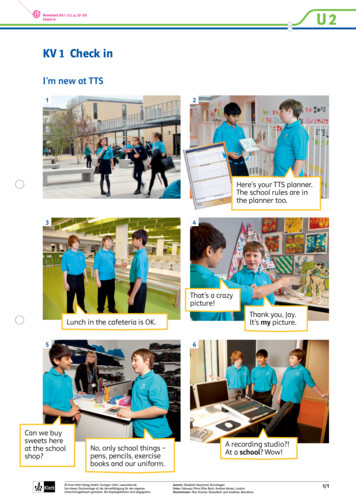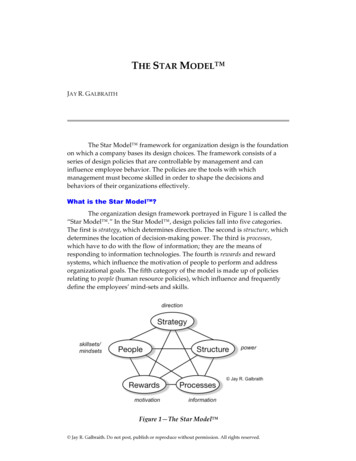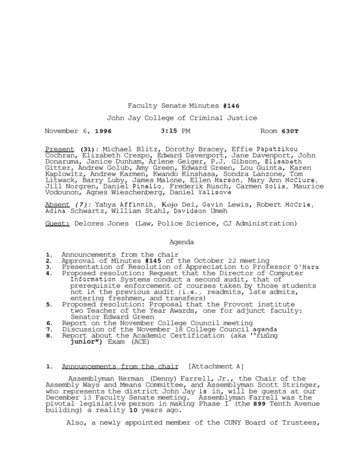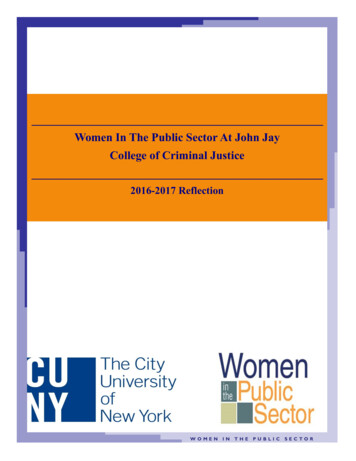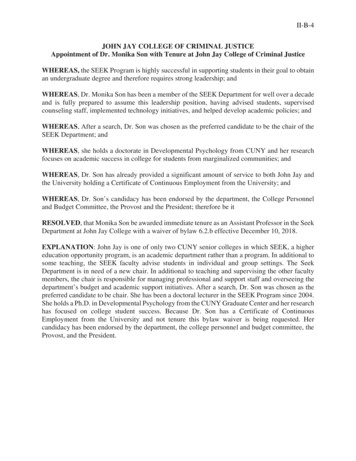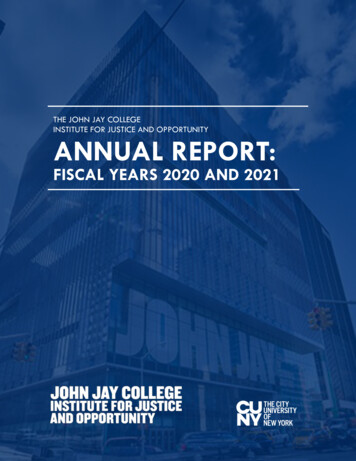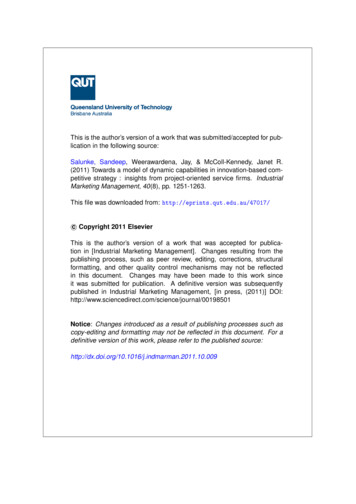
Transcription
This is the author’s version of a work that was submitted/accepted for publication in the following source:Salunke, Sandeep, Weerawardena, Jay, & McColl-Kennedy, Janet R.(2011) Towards a model of dynamic capabilities in innovation-based competitive strategy : insights from project-oriented service firms. IndustrialMarketing Management, 40(8), pp. 1251-1263.This file was downloaded from: http://eprints.qut.edu.au/47017/c Copyright 2011 ElsevierThis is the author’s version of a work that was accepted for publication in [Industrial Marketing Management]. Changes resulting from thepublishing process, such as peer review, editing, corrections, structuralformatting, and other quality control mechanisms may not be reflectedin this document. Changes may have been made to this work sinceit was submitted for publication. A definitive version was subsequentlypublished in Industrial Marketing Management, [in press, (2011)] 0198501Notice: Changes introduced as a result of publishing processes such ascopy-editing and formatting may not be reflected in this document. For adefinitive version of this work, please refer to the published 10.009
Towards a model of dynamic capabilities in innovation-based competitive strategy: Insightsfrom project-oriented service firmsSandeep Salunke*Postdoctoral Research FellowAustralian Centre for Entrepreneurship Research,Queensland University of Technology 4001AustraliaPh: 61-7-3138 9941Fax: 61-7-3138 5250Email: sandeep.salunke@qut.edu.auJay WeerawardenaAssociate Professor in Marketing & Competitive StrategyUQ Business School, University of Queensland 4072AustraliaPh: 61-7-3346 8093Fax: 61-7-3346 8166Email j.weerawardena@business.uq.edu.auJanet R. McColl-KennedyProfessor of MarketingUQ Business School, University of Queensland 4072AustraliaPh: 61-7-3346 8178Fax: 61-7-3346 8166Email j.mccoll-kennedy@business.uq.edu.au* Author for correspondenceAcknowledgementsWe gratefully appreciate the financial assistance provided to this research by the UQ BusinessSchool. We also acknowledge the assistance and input provided by Don Rivers, GeneralManager, Project Services, Department of Public Works, Queensland, Australia. Our sincerethanks for the comments provided by the three anonymous reviewers and the feedback by Dr.Henri Burgers which greatly helped in improving the original manuscript.Page 1 of 48
Author bios:Sandeep Salunke (Ph.D., University of Queensland) is a Postdoctoral Research Fellow at theAustralian Centre for Entrepreneurship Research, Queensland University of Technology,Brisbane, Australia. His academic research interests focuses on service innovation-basedcompetitive strategy in project-oriented firms, dynamic capabilities, entrepreneurial opportunitiesand service entrepreneurship. His research work has been presented at several internationalconferences and has also been accepted for publication in leading academic journals including,Industrial Marketing Management and Journal of Business Research.Jay Weerawardena (Ph.D., Griffith University) is an Associate Professor of Strategic Marketingat the UQ Business School, The University of Queensland. His primary research interests includedynamic capabilities and innovation-based competitive strategy. He has also been active in nonprofit competitive strategy, service innovation and born global firm internationalisation. He haspublished in several international journals including Journal of World Business, InternationalMarketing Review, Journal of Business Research, Journal of Strategic Marketing, EuropeanJournal of Marketing and Industrial Marketing Management.Janet McColl-Kennedy (Ph.D., University of Queensland) is Professor of Marketing in the UQBusiness School, The University of Queensland. She is recognized internationally as a leadingresearcher in services marketing, particularly service delivery, service recovery and emotions.Her work consistently appears in the top journals in her field including, Journal of Retailing,Journal of the Academy of Marketing Science, Leadership Quarterly, Journal of ServiceResearch, California Management Review, Journal of Business Research, and IndustrialMarketing Management. She is a Fellow of the Australian Marketing Institute.Page 2 of 48
Research highlights: Insights from project-oriented firms uncover the role of dynamic capabilities ininnovation and competitive strategy. Using a knowledge-based approach, the paper identifies four key dynamic learningcapabilities that service firms rely on. Project-oriented service firms create, extend and modify routines to systematically buildand nurture dynamic capabilities. The dynamic capabilities that provide firms with competitive advantage are built andnurtured by service entrepreneurship. A parsimonious model of service innovation-based competitive strategy comprising ninetestable propositions is presented.Page 3 of 48
ABSTRACTWith the growing significance of services in most developed economies, there is an increasedinterest in the role of service innovation in service firm competitive strategy. Despite growingliterature on service innovation, it remains fragmented reflecting the need for a model thatcaptures key antecedents driving the service innovation-based competitive advantage process.Building on extant literature and using thirteen in-depth interviews with CEOs of project-orientedservice firms, this paper presents a model of service innovation-based competitive advantage.The emergent model suggests that entrepreneurial service firms pursuing innovation build andnurture a set of dynamic capabilities that enable them to achieve greater innovation and sustainedcompetitive advantage. Our findings indicate that firms purposefully use create, extend andmodify processes to build and nurture key dynamic capabilities. The paper presents a set oftheoretical propositions to guide future research. Implications for theory and practice arediscussed. Finally, directions for future research are outlined.Key words: Dynamic capabilities, Service innovation, Competitive strategy, Project-orientedservice firms, Service entrepreneurship.Page 4 of 48
1. IntroductionThe growing significance of services in driving productivity, economic growth andemployment in countries which have traditionally relied on manufacturing is increasinglyevident. Accordingly, the share of revenue derived from services in Fortune 500 companies hasgrown considerably over the past few decades1, forcing organizations to calibrate their existingbusiness models to adopt a service-centric view. For example, IBM, which was once viewed as amanufacturing giant, has reoriented its business to provide solution based service, positioningitself as the ‘largest service business’ in the world (Zeithaml, Bitner, & Gremler, 2009). Asservices increasingly drive firm value, innovation becomes an effective way to accelerate growthand profitability, contributing to novel ways of new value creation (Berry, Shankar, Parish,Cadwallader, & Dotzel, 2006).Service innovation has been characterized as distinct from manufacturing innovation, withseveral researchers suggesting that there are important differences. For example, co-creation atthe client-provider interface; the incremental and continuous nature of service innovation; the‘fuzzy’ nature of the service innovation output; the absence of ‘developmental stages’ and R&Ddepartments in service firms – all suggest that service innovation may be inherently differentfrom manufacturing innovation. Similarly, Service Science literature emphasizes co-creation ofvalue with customers/ clients. Unlike the traditional manufacturing-based approach where valueis created for the customer, a service approach entails creation of value with the customer as acollaborative partner (Kowalkowski, 2011; Ordanini & Parasuraman, 2011; Vargo & Lusch,2004). Here value creation is driven by unique client needs and based on the principle ofreciprocity between the service provider and the client. Yet, service innovation thought is stilllargely based on a manufacturing mindset (Gallouj & Windrum, 2009), even though innovation1(Moller, Rajala, & Westerlund, 2008)Page 5 of 48
in services has been shown to be different in that imitation is widespread, especially, in thefinancial services sector (e.g., Davison, Watkins, & Wright, 1989; Teixeira & Ziskin, 1993).While there has been a strong emphasis in service innovation literature on the success factors(Avlonitis & Papastathopoulou, 2001; Cooper & de Brentani, 1991; De Brentani, 1991;Easingwood & Storey, 1993), there has been less research on how new value is co-created andsustained through innovation. This service centered view which is more customer-oriented andrelational needs closer examination in relation to value co-creation and the sources of competitiveadvantage (Bharadwaj, Varadarajan, & Fahy, 1993)Although it is commonly understood that service innovation-based advantages cannot besustained, this observation is predominantly based on research conducted in financial serviceswhere imitation is rampant. However, a growing number of researchers suggest that serviceinnovation-based advantages can be sustained (e.g., Bharadwaj, et al., 1993; Gustafsson &Johnson, 2003; Kandampully & Duddy, 1999). While this debate remains inconclusive, ithighlights the need for research to model the antecedents of service innovation and to examineinnovation-based strategy in industry settings where long-term customer/client involvement isevident. Overall, there is a need for a theoretical framework that captures the antecedent factorsdriving innovation-based competitive strategy in service firms.Addressing this need, this paper attempts to build a coherent theoretical framework ofinnovation-based competitive strategy in project-oriented service firms2 by drawing on thedynamic capability-based view of competitive strategy and using multiple case study evidence.Project-oriented firms are characterized by relatively long project life cycles where the provisionof service often involves close collaboration with the client, reflecting client input to the2Project oriented firms deliver services to clients using projects (e.g., engineering and construction firms,consultancies, system integrators and architectural firms)Page 6 of 48
innovation process. These firms co-create value by working closely with clients on a continuousbasis to provide effective solutions. Providing solutions not only needs technical knowledge, butalso requires an in-depth understanding of the client’s industry and business processes. Therefore,project-oriented firms provide an appropriate setting to examine service innovation-basedcompetitive strategy. Findings from in-depth case interviews with 13 project-oriented firmssuggests that service entrepreneurs build and nurture a set of dynamic capabilities that drives theservice innovation and competitive advantage process. This evidence is used to develop anemergent model of service innovation-based competitive strategy, together with a set of testablepropositions.The paper is structured as follows. First, the theory of competitive strategy is brieflyrevisited with specific attention given to the dynamic capability-based view of competitivestrategy. Second, the literature on service innovation-based competitive strategy is reviewedhighlighting existing gaps in the literature. This is followed by a brief discussion of the researchmethod. Third, drawing on the literature and case study findings, a new conceptual model isdeveloped with a set of theoretical propositions. Finally, the implications of the emergent modelfor theory and practice as well as directions for future research are presented.2. Conceptual background2.1. The dynamic capability-based view of competitive strategyThe dynamic capability-based view (DCV) of competitive strategy attempts to explainwhy some firms gain competitive advantage in continually changing environments (Eisenhardt &Martin, 2000; Teece, Pisano, & Shuen, 1997). Dynamic capabilities are the antecedentorganizational and strategic routines by which managers alter their resource base - acquire andshed resources, integrate them together, and recombine them - to generate new value-creatingstrategies (Grant, 1996; Pisano, 1994), which essentially is an act of innovation (Porter, 1990).Page 7 of 48
Unlike its predecessor, the resource-based view (RBV) (c.f. Barney, 1991), the DCV assigns aprominent role to the firm’s strategic leadership in the nurturing and building of dynamiccapabilities critical to the value generation process.Although early research on dynamic capabilities suggests a link to competitive advantage(Griffith & Harvey, 2001; Lee, Lee, & Rho, 2002; Teece, et al., 1997), there has been lack ofagreement on the nature of this relationship. For example, Cepeda and Vera (2007) argue that thelink between dynamic capabilities and competitive advantage as presented in early definitions ofdynamic capabilities is tautological as researchers have tended to claim dynamic capabilities posthoc, inferring their existence from successful organizational outcomes such as profitability andgrowth. Eisenhardt and Martin (2000, p. 1107) provide an alternate view and argue that ‘dynamiccapabilities are the organizational and strategic routines by which firms achieve new resourceconfigurations as markets emerge, collide, split, evolve, and die’.More recently, Helfat et al. (2007) building on prior literature define dynamic capabilitiesas “the capacity of an organization to purposefully create, extend or modify its resource base” (p.4). This definition while highlighting the key processes involved in the dynamic capabilitybuilding process, comprehensively captures the essence of prior work in this area. The currentpaper combines Helfat et al.’s (2007) definition with Zollo and Winter’s (2002) view to formulatea knowledge-oriented definition of dynamic capabilities. Here, dynamic capabilities are definedas: The capacity of an organization to purposefully create, extend or modify its knowledgerelated resources, capabilities or routines to pursue improved effectiveness. This knowledgebased view of dynamic capabilities implies that organizations learn from internal and externalsources to build and nurture knowledge assets where organizational learning refers to the processof improving actions through better knowledge and understanding (Fiol & Lyles, 1985).Page 8 of 48
Consistent with this view, the competitors’ inability to easily duplicate a capabilitiesbased value creating strategy is suggested as a key source of sustained competitive advantage(Grant, 1991, 1996). The sustainability of competitive advantage relies on the “capabilitydifferential” on which the competitive strategy is founded (Hall, 1993). Further, Eisenhardt andMartin (2000) point out that ‘long-term competitive advantage lies in resource configurations thatmanagers build using dynamic capabilities, not in the capabilities themselves’ (p. 1117). Thus,the dynamic capability view of competitive strategy provides a robust theoretical foundation tounderstand how a firm creates new resource combinations in its pursuit of competitive advantageand to model the antecedents of service innovation in a project-oriented context. We conjecturethat dynamic capabilities enable project-oriented firms to create new knowledge-based resourcecombinations enabling them to undertake service innovation. Although this view has beendiscussed in prior research (e.g., Bharadwaj, et al., 1993; Hall, 1993), it has escaped empiricalscrutiny. The competitors’ inability to imitate dynamic capabilities is a source of sustainedcompetitive advantage.2.2. Literature on service innovation-based competitive strategyThe literature on service innovation-based competitive strategy has progressed aroundfour key themes: (1) modeling the service development process; (2) conceptualization of theservice innovation construct; (3) the role of the strategist in the innovation process and; (4) theissue of sustaining the innovation-based competitive advantage. Each is discussed in turn.2.2.1. Modeling the service development processService innovation researchers have attempted to capture the key activities that constitutethe service development process and have developed linear or sequential models detailing theprocess activities and stages. The majority of these efforts looked at how different stages in thedevelopment process are carried out and had an implicit emphasis on improving firmPage 9 of 48
performance based on an efficient service development process. Early innovation models reflect aheavy reliance on new product development (NPD)-based models (c.f. Bowers, 1989; Scheuing& Johnson, 1989) and reflected improvements over the initial normative process model proposedby Booz-Allen (1982). Subsequent research suggested that many stages in the servicedevelopment process overlap and cannot be clearly identified (e.g., Alam & Perry, 2002;Edvardsson, Haglund, & Mattsson, 1995). Much of this latter research established that the servicedevelopment process is inherently different from the NPD process (c.f. Johne & Storey, 1998).While attempts have been made to understand the complexities involved in the servicedevelopment process, there is limited understanding of the performance drivers and theunderlying capabilities or competencies (Johne & Storey, 1998) with two notable exceptions.These are work by Papastathopoulou, Gounaris and Avlonitis (2006), who found that theinvolvement of different functions during the service innovation process influences differentaspects of performance and the work by Bharadwaj et al. (1993), who proposed a comprehensivemodel consisting of more than 35 variables that focus on the distinctive organizational skills andresources underlying sustained competitive advantage in service firms. Although thesecontributions have enriched our understanding in this area, a well-founded model of serviceinnovation-based performance and competitive strategy that can be tested is yet to be proposed.2.2.2. Conceptualization of the service innovation constructDespite several attempts to conceptualize innovation in service firms, these have mainlyfocused on the “types” and the “degrees” of service innovation (e.g., Johne & Storey, 1998;Lovelock, 1984). A minority have conceptualized the dimensionality of service innovation (e.g.,Den Hertog, 2000; Den Hertog, Wietze, & De Jong, 2010; Edvardsson & Olsson, 1996). Forinstance, Edvardsson and Olsson (1996) propose service innovation as comprising the serviceconcept, service process and service system. These conceptualizations are based on the notion ofPage 10 of 48
manipulation of knowledge resources (e.g., Grant, 1996) with the customer need in particular asthe starting point. That is, the innovation process revolves around the customer logic and theknowledge acquired therein. While these conceptualizations have contributed to a greaterunderstanding of the service innovation construct, they have not been operationalized.Based on this discussion, we conceptualize service innovation as the extent to which newknowledge is integrated by the firm into service offerings, which directly or indirectly results invalue for the firm and its customers/clients. This captures both continuous and discontinuousinnovation (e.g., Johne & Storey, 1998; Lovelock, 1984) and brings in value creation criteriasuggested in the literature (McKinsey & Co, 1993) as an important ingredient in innovation.2.2.3. The role of the strategist – A neglected factor in service innovation process?Management is responsible for the formulation of new service objectives and strategicfocus. Service innovation researchers suggest that top management (Cooper, Easingwood, Edgett,Kleinschmidt, & Storey, 1994; De Brentani, 1991; Drew, 1995) as well as middle management(Athanassopoulou & Johne, 2004) play an important role in driving service development. A clearcorporate vision underpinned by specific goals and an appropriate culture fosters successfulservice development (Johne & Storey, 1998). While management’s role has been highlighted ascontributing to innovative organizational culture (Johne & Storey, 1998), the role that managersplay in the service innovation process has received limited attention. Accordingly, it is not clearhow innovation is managed in service firms and the role entrepreneurial key decision-makersplay in the development of capabilities driving the service innovation process.2.2.4. Sustainability of service innovation-based advantagesInnovation in services is seen as largely incremental (Johne & Storey, 1998) and imitationhas been followed by many service firms as a specific strategy (Easingwood, 1986; Hooley &Mann, 1988; Scheuing & Johnson, 1989). This is particularly evident in the insurance andPage 11 of 48
financial services sectors (Davison, et al., 1989; Teixeira & Ziskin, 1993) and could be attributedto difficulties associated with patenting services (Cowell, 1988) and the ease of copyingsuccessful new services (Kelly & Storey, 2000). The ease of copying new services has resulted in“a dangerous focus on ‘me-too’ products” with radical innovation taking a backseat (Johne &Storey, 1998, p. 205)While a number of service innovation researchers agree that service firms followimitation, it appears that service firms continue to rely on innovation to create customer value andensure growth (Moller, et al., 2008). This view has found support with other researchers (e.g., DeBrentani, 1991; Matear, Gray, & Garrett, 2004) who find that service firms use innovation to gaincompetitive advantage. While few researchers argue that these advantages can be sustained (e.g.,Coyne, 1993; Kaplan, 2000; Morris & Westbrook, 1996; Storey & Kahn, 2010), the debateremains inconclusive.Overall, although the literature on service innovation-based competitive strategy hasdeveloped it is still fragmented with the majority of researchers focusing on success factors ofinnovations. Literature attempting to model the service innovation-based competitive strategyprocess is limited. Our review of literature also highlights the lack of sufficient evidence tosupport the dimensionality of the service innovation construct and that the debate on whetherinnovation-based competitive advantages can be sustained remains inconclusive. Similarly,although the dynamic capability view of competitive strategy has been widely adopted inmainstream competitive strategy literature, there has been no attempt to examine service firmcompetitive strategy using this view. Hence, there is a need for a theoretical framework thatcaptures the service innovation-based competitive strategy process that can be successfullyoperationalized.3. MethodPage 12 of 48
3.1. SampleProject-oriented service firms provide an ideal setting to investigate innovation-basedcompetitive strategy. Projects are task-oriented, adaptable and flexible and provide an idealmechanism to provide specific services for clients and often involves co-creation of services(Acha, Gann, & Salter, 2005). In this study we extend the definition of Blindenbach-Driessen andvan den Ende (2006) in defining a project-oriented service firm as “a service firm skilled atorganizing tasks around projects in anticipation and response to client requirements and in whichthe needs of the project outweigh other considerations in the firm’s decision making”. Projectoriented service firms potentially reflect several characteristics unique to service settings. Inaddition to the co-production aspect discussed above, project activities and outcomes are uniqueand customer centric (Davies & Hobday, 2005), often reflecting the service characteristics ofintangibility, perishability, heterogeneity and inseparability (Berry, 1980). Project-oriented firmscombine the advantages of a project-based setup (e.g., flexible, flat paced) with that of afunctional structure by setting up project teams by retaining and rotating people within differentprojects and thus accumulating knowledge gained from each project. Examples includeengineering and construction companies, consultancies, system integrators and architectural firmsthat predominantly operate within business-to-business environments.Consistent with the case study methodology (Yin, 2009) and as recommended byHutchinson (1993) we conducted a multi-firm field study using a diverse sample of national andinternational project-oriented service firms located in a major Australian capital city.Accordingly, project-oriented firms that offered services including architectural, construction,maintenance, consultancy and market-research were selected. In line with our research objective,we chose to analyze the ‘firm’ as opposed to the ‘project’. Sampling proceeded until “theoreticalsaturation” – a point where no additional data is found and the category becomes stable and richPage 13 of 48
in detail (Glaser & Strauss, 1967). Initially, we consulted established databases (e.g., Dunn &Bradstreet) to gather information, select and approach the key informants in the chosen key firms.Following Alam (2002), who suggested that very small service firms are less likely to havesufficient resources for innovation, we approached firms with at least 20 employees. Initially wesent letters inviting potential respondents, however, as the study progressed, we followed thesnowball technique where informants were referred to by interviewees. The gathered informationincluded the general nature of the business operations, the history, the management team, thenumber of employees and the demographic information about the firm. This information wassupplemented by information on the firm’s website which was confirmed during the interviews.Table 1 provides a brief summary of the profiles of the selected t Table 1 about here---------------------------------------3.2. Interview processConsistent with Eisenhardt’s (1989) recommended procedures, we entered theorganizations with a well-defined focus. The literature review undertaken for the study suggestedthe presence of a well-developed body of knowledge on the dynamic capability-based view ofcompetitive strategy and a fragmented body of literature on service innovation and competitiveadvantage, both of which inform this research (Yin, 2009). This led to a priori specification ofactivities driving innovation in service firms which was derived from the preceding literaturereview. However, the researchers assumed no preordained theoretical relationships among theseactivities. In following this direction, we were alert to the identification of activities specific tothe service innovation context and to developing context-related specifications to enable theirinclusion in the emerging theory.Page 14 of 48
In-depth interviews with CEOs and senior managers were conducted in each of theselected project-oriented organizations. Respondents who agreed to participate were contactedprior to the interview and briefed about the purpose of the study. Retrospective, reflexiveaccounts provided by these key informants (e.g., Partington, 2000) provided the basic buildingblocks to gain insights into the phenomenon of service innovation-based competitive strategy.The interviews were exhaustive ranging from 60-75 minutes and conducted by two interviewerssimultaneously, which facilitated in-depth coverage of issues and probes where necessary. Openended prompts and probes were used to elicit further discussion from participants on a givenquestion (Creswell, 2009). An interview protocol3 consisting of questions relating to serviceinnovation guided the interview process. The interview protocol was customized for each firmusing publicly available information available on the firm’s website. Interviews were conductedin accordance with the key points listed in the interview protocol and a strict criterion wasfollowed in relation to the coverage of these points. We followed an emergent design method(Taylor & Bogdan, 1984) by which questions were added, deleted and modified throughout theresearch process. To begin with, our initial set of questions was designed to motivate informantsto talk in general about the organization and their competitive environment. Once they werecomfortable discussing the general business and the competition, we began to delve morethoroughly into the specifics of competitive advantage, the role of service innovation and thesustaining of advantages issues. If the interviewee stated that he was not privy to the specificinformation that was being asked, the respondent was requested to refer us to another personwithin the organization who would be able to help us out. While this was not the case in themajority of the firms, only one firm (Case M) advised us to speak to another senior manager togain additional insights to the questions.3A copy of the interview protocol used in this study will be provided upon request.Page 15 of 48
3.3. AnalysisInterviews were recorded, transcribed and analyzed using coding procedures described byMiles and Huberman (1984). Each interview on an average yielded just over 20 pages comprisingabout 1000 lines of transcript. We followed a systematic step-wise recursive process suggestedby Braun and Clarke (2006) in the thematic analysis of the data to identify repeated patterns ofmeaning relevant to this research. First, the 14 transcripts were read several times by theresearchers to familiarize with the data. Second, coding was followed to enhance internal validity(Pandit, 1995) and is understood here as “representing the operations by which data are brokendown, conceptualized and put back together in new ways” (Flick, 2002). In other words, codinginvolves organizing of data into meaningful groups and was ‘data-driven’. A
UQ Business School, University of Queensland 4072 . Email j.weerawardena@business.uq.edu.au Janet R. McColl-Kennedy Professor of Marketing UQ Business School, University of Queensland 4072 Australia Ph: 61-7-3346 8178 Fax: 61-7-3346 8166 Email j.mccoll-kennedy@business.uq.edu.au * Author for correspondence Acknowledgements

